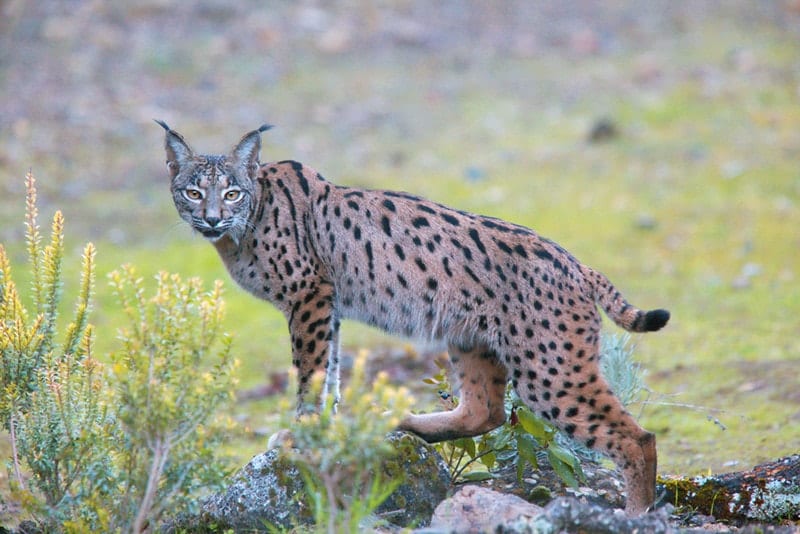Far too many species are disappearing due to human activity and interference, and felines are not immune to becoming endangered and eventually extinct. It’s vital to be aware of the problem; otherwise, how can it ever get fixed? Here’s a list of seven of the most endangered feline species. The first two are critically endangered, which is a step before extinction.
The 7 Endangered Feline Species
1. Amur Leopard (Critically Endangered)
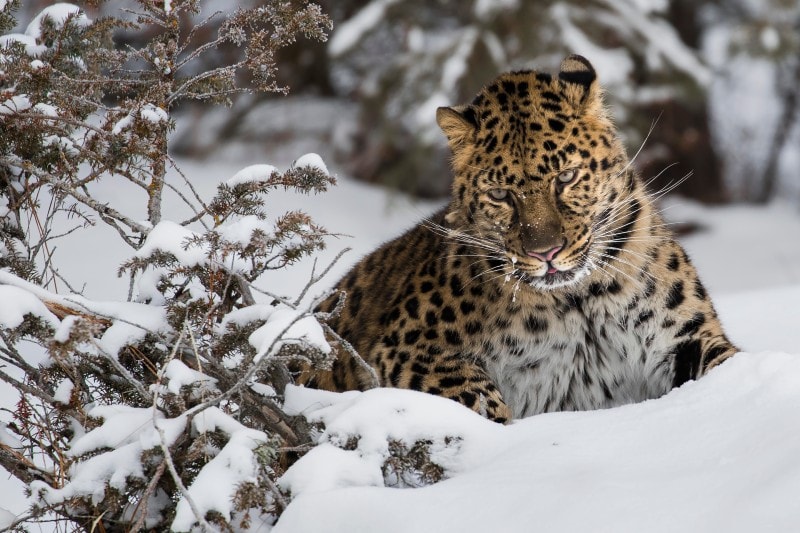
Distribution
The Amur Leopard lives in elevated areas in Russia and China among rugged hills, watersheds, and rocky outcrops. They survive in a snowy, cold climate, and their habitat is based on where most of their prey, the sika deer, are present. Individual Amur Leopards tend to avoid the territories of others.
Appearance
The Amur Leopard has the traditional dark-brown rosettes covering their coat, but their pale, cream fur distinguishes them from other leopards. Their coat is also heavier due to the cold climate in which they live.
Their rosettes are also unique because they are widely spaced and have thick black borders.
Diet
Amur Leopards are talented stalkers and can take down prey 10 times their weight. Their main prey are the Manchurian sika deer, Ussuri wild boar, and Siberian roe deer.
They go after smaller prey, too, including mice, birds, rabbits, weasels, and badgers.
Level of Endangerment
The Amur Leopard is the most endangered big cat in the world. There haven’t been any recent counts of the Amur Leopard population, but in 2015, it was estimated that there were fewer than 60. However, the conservation efforts have increased, and it’s believed that there are currently over 100.
This is still insufficient to keep them from extinction, but a national park called the Land of the Leopard National Park was created in 2012. It covers 2,630 square kilometers, which has helped increase their numbers slowly, but there’s still a long way to go.
2. Iriomote Cat (Critically Endangered)
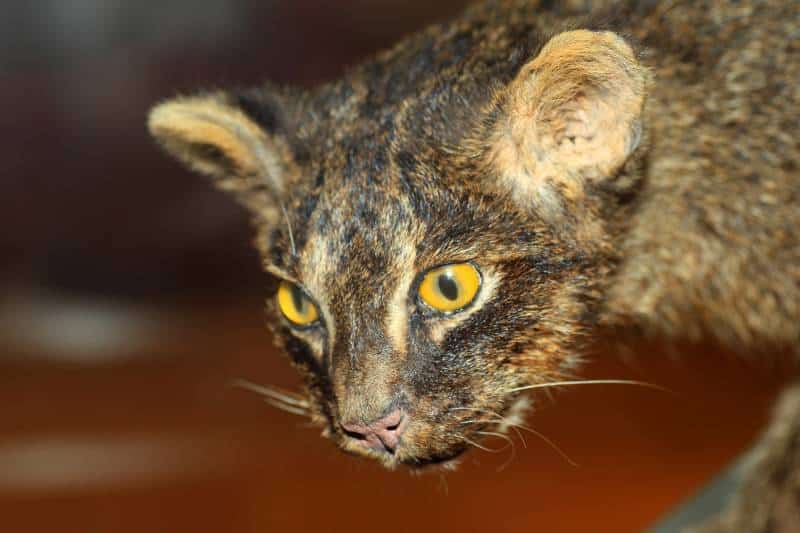
Distribution
The Iriomote Cat can only be found in one region: the Iriomote Island in Japan. It contains subtropical forests and slightly elevated areas. The Iriomote Cat prefers to inhabit areas near rivers, the edge of forests, and places with low humidity levels.
Appearance
Their coat is a combination of grays and browns, with a variety of dark-brown spots and stripes. They weigh 7 to 11 pounds and are quite small, though Iriomotes are a subspecies of leopards.
Diet
Iriomote Cats are carnivores and eat primarily small mammals, including rats and fruit bats, as well as snakes, lizards, frogs, birds, insects, and occasionally, crabs and fish.
Level of Endangerment
There aren’t any recent numbers on the Iriomote Leopard’s population status. As of 2007, it’s believed that there are about 100 to 109 remaining, and their numbers are declining.
3. Andean Mountain Cat (Endangered)
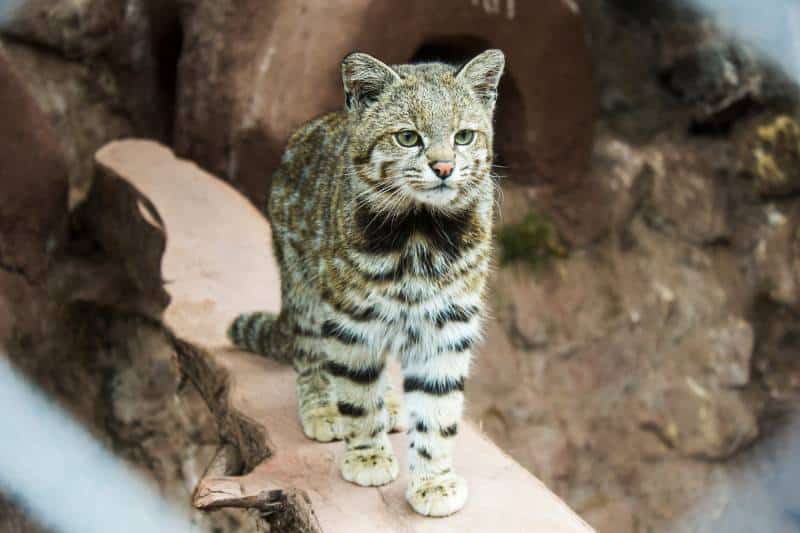
Distribution
The Andean Mountain Cat lives in the higher elevations of the Andes, and they can survive as high up as 1,800 meters. They can be found in the Andes’ semi-arid and rocky arid areas, though their preferred habitat is in valleys with sporadic rock walls.
Appearance
The Andean Mountain Cat has an ashy-gray color with brownish spots that make up a series of lines that give the appearance of stripes. Their coat is thick and plush, and they have rounded ears. They are also relatively small, about the size of a house cat at 8 to 13 pounds.
Diet
The Andean Cat eats small birds, mammals, lizards, and waterfowl. Their primary prey is the mountain Viscacha, a rodent similar to the chinchilla.
Level of Endangerment
The last assessment of the Andean cat population was in 2014 when there were 1,378 adults. That might sound like a large number compared to the Amur Leopard and Iriomote Cat, but the population is in decline. While regulations protect the cat, enforcing the law in the area is challenging.
4. Borneo Bay Cat (Endangered)
Distribution
The Borneo Bay Cat is only found in Borneo, and they weren’t known to exist until one was caught in 1994. They live in swamps, rainforests, and lowlands and are usually spotted near rivers.
Appearance
The Borneo Bay Cat has rich chestnut fur with a darker, reddish-colored tail. They have round ears with black fur and a round head with two lines that run from their eyes to the back of their head. This small cat weighs 6 to 9 pounds.
Diet
The Borneo Bay Cat eats birds, small rodents, monkeys, and carrion.
Level of Endangerment
The Borneo Bay Cat had an assessment of their population in 2014 when there were 2,200 adult cats. Their population is still on the decline.
5. Flat-Headed Cat (Endangered)
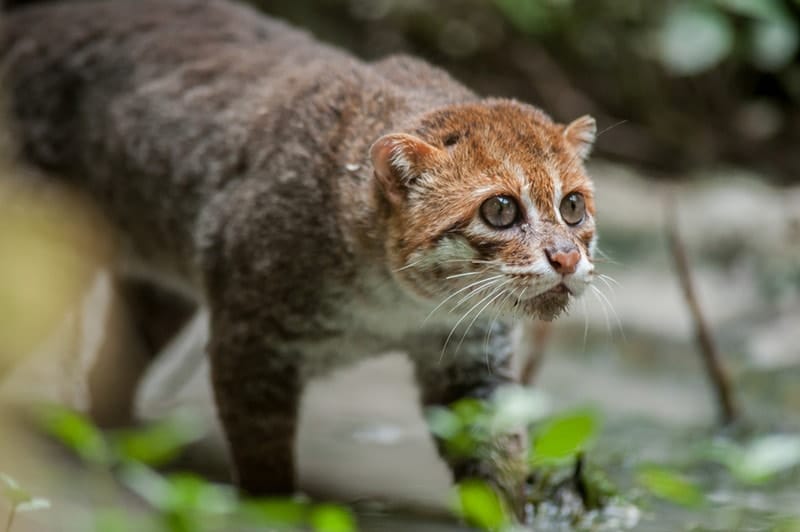
Distribution
The Flat-Headed Cat lives on the southern side of Thailand, Sumatra, Borneo, and Malaysia. They stay near coastal areas and new lowlands, typically near freshwater.
Appearance
The Flat-Headed Cat has a distinctive head. They have a compressed skull, which gives their head a cylindrical shape, and their canine teeth are noticeably large (when they open their mouths).
They have thick reddish-brown fur and a white-spotted underbelly. The fur on their face is lighter than the rest of their body, and their claws are not retractable. This small species weighs 3 to 6 pounds.
Diet
The Flat-Headed Cat lives near water, and their main diet is fish and frogs, but they also eat birds, rodents, and fruit.
Level of Endangerment
The Flat-Headed Cat was assessed in 2014; at that time, the population was 2,499 mature adult cats. Their population is decreasing.
6. Iberian Lynx (Endangered)
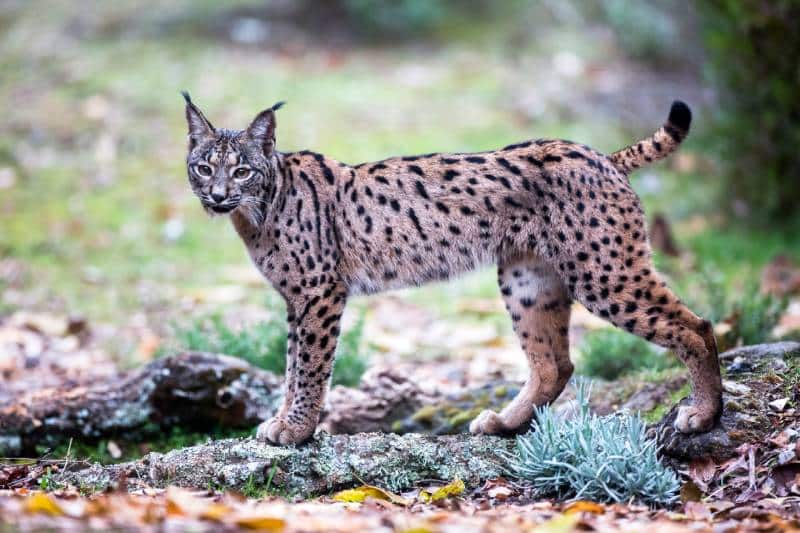
Distribution
The Iberian Lynx was once prevalent in the Iberian Peninsula region, but now they are found in southern Spain and northern Portugal. They spend most of their time in dense shrubs and open grasslands.
Appearance
The Iberian Lynx has an orange-yellow coat with dark spots in different sizes. Like all lynxes, they have noticeably tufted ears. They weigh 15 to 33 pounds.
Diet
The primary prey for the Iberian Lynx is rabbits, but they will also eat young deer, ducks, and partridges when rabbits are in short supply.
Level of Endangerment
The assessments for the population of the Iberian Lynx were conducted in 2014 when there were 156 adults. However, the population is on the rise.
7. Tiger (Endangered)
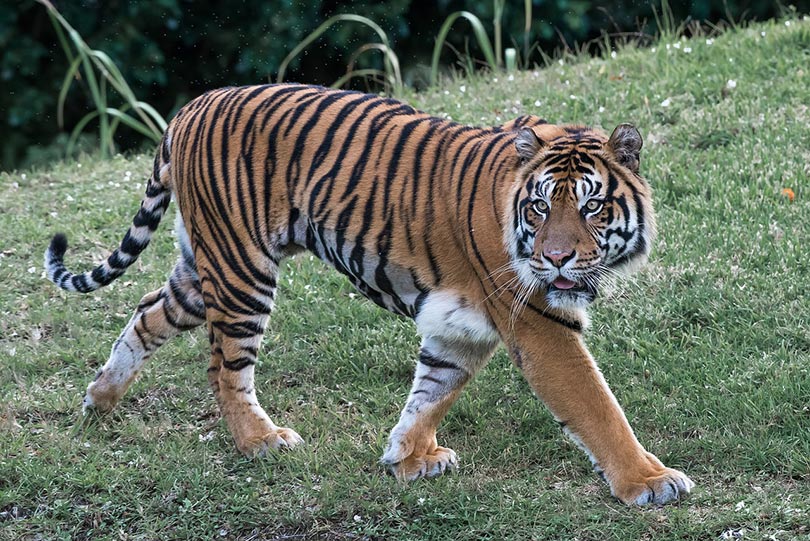
Distribution
The Tiger almost doesn’t need an introduction. Their distribution is widespread, and they can be found in many countries, like China, India, and Russia, so their habitat is also diverse.
Appearance
There are many subspecies of Tigers, but all have shades of orange with striking black stripes. Tigers are the largest of all feline species and can weigh 200–660 pounds!
Diet
The sheer size of the Tiger shows they need large prey. They eat everything from goats and buffalo to horses, deer, and the occasional human.
Level of Endangerment
There are nine subspecies of Tigers, but unfortunately, three are extinct. The other six are the Sumatran, Siberian (or Amur), Bengal (or Indian), South China, Malayan, and Indo-Chinese Tigers.
The number of Tigers has fallen by 95% within the last century. The six surviving species of Tigers are all endangered, some more than others. IUCN assessed all Tigers in 2021, and the numbers range from 2,608 to 3,140, and the numbers are decreasing. It’s hard to imagine a world without the Tiger.

Vulnerable Feline Species
We covered all the critically endangered and endangered feline species. The IUCN has seven categories:
- Least Concern
- Near Threatened
- Vulnerable
- Endangered
- Critically Endangered
- Extinct in the Wild
- Extinct
The feline species in the vulnerable category are listed here because they are just a step away from becoming endangered:
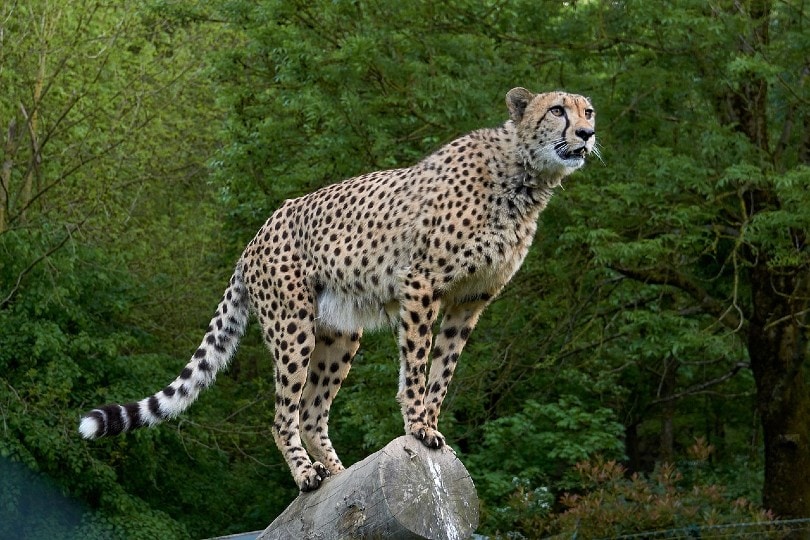
- African Golden Cat: This cat lives in west and west-central Africa. Their numbers are decreasing, and they are rarely seen, but IUCN does not have any specifics.
- Black-Footed Cat: This feline is found in southern Africa, and there were 9,707 adult cats in 2014. Their numbers are decreasing.
- Cheetah: They range widely across the African continent. In 2021, there were 6,517 adult cats, and their numbers are decreasing.
- Chinese Mountain Cat: This feline is found primarily on the Qinghai-Tibet Plateau in China. Their population was 1,177–23,540 in 2021 and is decreasing.
- Clouded Leopard: This feline is found in the cloud forests of Southeast Asia. In 2021, there were 3,700–5,580 cats, which is decreasing.
- Fishing Cat: This feline is found in south and southeast Asia. IUCN doesn’t have the exact numbers, but they are decreasing.
- Guiña: This feline resides in central and southern Chile. In 2014, the population of adult cats was 5,980–92,092. They are also decreasing.
- Leopard: This feline is found across most of Africa and parts of Asia. IUCN doesn’t have the exact numbers, but the populations of all subspecies of the Leopard family are decreasing.
- Lion: This feline lives on the southern fringe of the Sahara to northern South Africa. The population was assessed in 2014, with 23,000–39,000 adults. As with the others, the Lion population is decreasing.
- Northern Tiger Cat: This feline lies in Costa Rica, Panama, South America, and central Brazil. In 2016, there were 8,932–10,208 adults, and the numbers are decreasing.
- Snow Leopard: This feline is found in central and south Asia mountain ranges. They were assessed in 2016 when there were 2,710–3,386 adults, and they are decreasing.
- Southern Tiger Cat: This feline lives in central and southern Brazil, eastern Paraguay, and north-eastern Argentina. In 2014, there were 6,047 adult cats, and the number is decreasing.
- Sunda Clouded Leopard: This feline is found in Borneo and Sumatra. In 2015, there were 4,500 adult cats, and the number is decreasing.
What Can You Do?
Every feline species that is vulnerable, endangered, and critically endangered continues to have decreasing numbers. You can help these and other endangered species through donations to reputable wildlife and nature conservation organizations. You can also volunteer at your local wildlife refuge or nature center.
Learn about endangered species, and educate your friends and family about taking steps to protect these felines. Get vocal through letter/email writing and posting about the species you’re the most passionate about on social media. Write to your Congressional representative about supporting the Endangered Species Act.
Also, try to be environmentally conscious: Recycle, use environmentally friendly products, and don’t purchase anything from an endangered species, such as ivory or coral.
 Conclusion
Conclusion
The destruction that humans continue to cause is leading to entire species disappearing forever. Fortunately, many conservation groups and locals in the countries of the vulnerable species are working tirelessly to protect them. Many have even lost their lives to this cause.
Awareness of these beautiful feline species and others at risk is the first step in making a difference.
Featured Image Credit: tony mills, Shutterstock
Contents
- The 7 Endangered Feline Species
- 1. Amur Leopard (Critically Endangered)
- Distribution
- Appearance
- Diet
- Level of Endangerment
- 2. Iriomote Cat (Critically Endangered)
- Distribution
- Appearance
- Diet
- Level of Endangerment
- 3. Andean Mountain Cat (Endangered)
- Distribution
- Appearance
- Diet
- Level of Endangerment
- 4. Borneo Bay Cat (Endangered)
- Distribution
- Appearance
- Diet
- Level of Endangerment
- 5. Flat-Headed Cat (Endangered)
- Distribution
- Appearance
- Diet
- Level of Endangerment
- 6. Iberian Lynx (Endangered)
- Distribution
- Appearance
- Diet
- Level of Endangerment
- 7. Tiger (Endangered)
- Distribution
- Appearance
- Diet
- Level of Endangerment
- Vulnerable Feline Species
- What Can You Do?
- Conclusion

